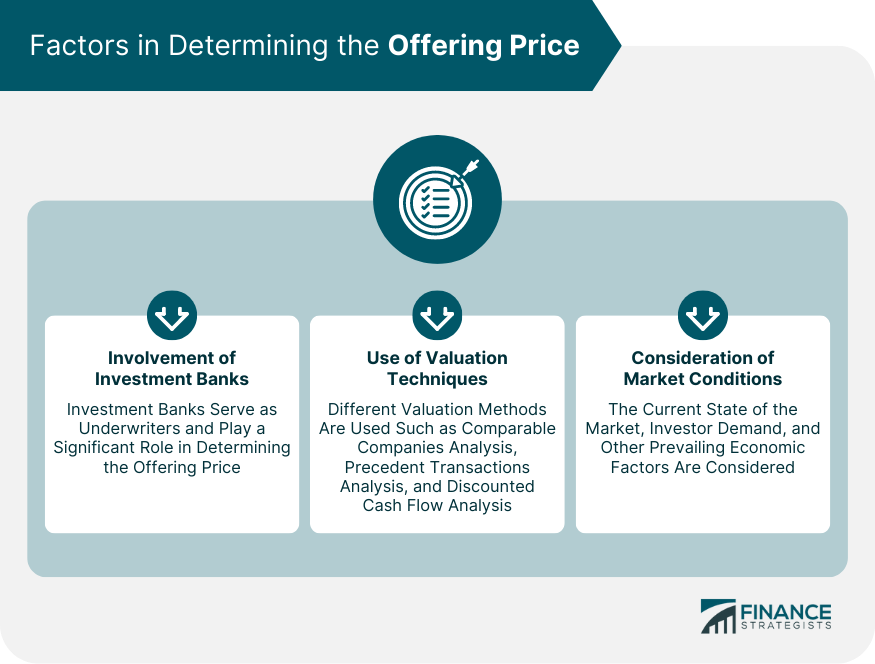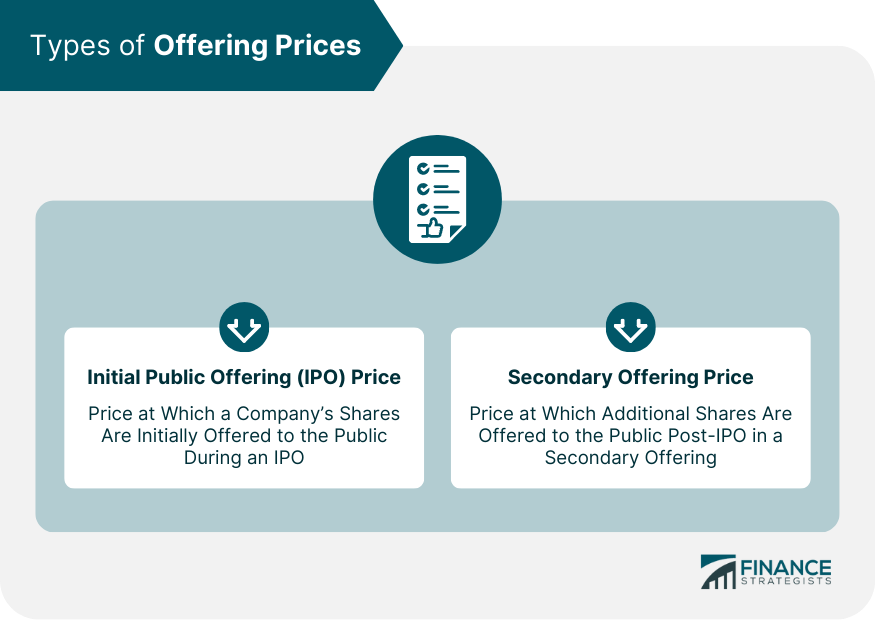The Offering Price, also known as the issue price or initial offer price, is the price at which securities, like stocks or bonds, are initially sold to the public by an issuing company during an Initial Public Offering (IPO), Follow-on Public Offering (FPO), or Rights Issue. This price is carefully determined based on the company's intrinsic value, growth prospects, and current market conditions. It represents the amount an investor needs to pay to purchase one unit of the security during the offering. Offering Price is fundamental in raising capital for companies; it also provides investors an entry point into ownership of the entity, determining their initial investment cost. Furthermore, the offering price sets the stage for the security's subsequent trading in the secondary market. Investment banks act as underwriters during an IPO. They perform due diligence, ensure regulatory compliance, and help determine the offering price. The bank's analysts conduct extensive research, including financial modeling and market analysis, to reach a reasonable offering price. Several valuation techniques are employed to arrive at the offering price. These techniques include Comparable Companies Analysis, Precedent Transactions Analysis, and Discounted Cash Flow Analysis. This method involves comparing the company in question with other similar companies that have been publicly traded. The performance, profitability, and market value of these comparable firms informs the determination of the offering price. This technique examines recent transactions involving similar companies. By analyzing these precedents, underwriters can get a sense of how the market may value the company. This method values a company based on its projected future cash flows, which are then discounted back to their present value. It provides a comprehensive view of the company's financial future, which is a significant consideration when setting the offering price. In addition to valuation techniques, market conditions play a crucial role in determining the offering price. These conditions include the overall economic environment, trends in the industry, investor sentiment, and market volatility. There are various types of offering prices depending on the nature of the security being issued. The two most common types are the Initial Public Offering (IPO) price and the secondary offering price. The IPO price is the price at which a company's shares are first sold to the public. The IPO process involves a complex interplay of valuation, investor demand, and regulatory requirements. The IPO process involves several stages, starting with the decision to go public, selecting an underwriter, filing required documents with regulators, marketing the IPO, and finally, pricing and issuing the shares. Each of these stages can influence the IPO price. A secondary offering occurs when a company issues additional shares after an IPO. The secondary offering price is typically determined based on current market conditions and the company's performance since its IPO. Secondary offerings are typically carried out to raise additional capital, pay off debt, or facilitate the exit of early investors. The offering price plays a significant role in the success of these offerings. The concept of offering price is not limited to the stock market. It also plays a crucial role in bond markets and real estate markets. In the equity market, the offering price is the price at which new shares are issued to the public. It plays a crucial role in determining how much capital a company can raise. In the bond market, the offering price is the price at which a bond is first sold to investors. It is typically set at par, but it can be more or less depending on market conditions and the creditworthiness of the issuer. In the real estate market, the offering price is the price at which a property is listed for sale. Like in other markets, various factors influence this price, including the property's condition, location, and prevailing market conditions. The offering price plays a significant role in market economics. It is influenced by supply and demand, market efficiency theories, and investor sentiment and behavior. In essence, the offering price reflects a balance between supply (the number of shares a company wishes to sell) and demand (how much investors are willing to pay for those shares). A high level of investor demand can lead to a higher offering price, while weak demand can result in a lower price. The Efficient Market Hypothesis suggests that securities are always priced correctly in that they reflect all available information. However, anomalies and market inefficiencies can sometimes result in mispriced offerings. Investor sentiment and behavior can significantly influence the offering price. Factors such as market sentiment, herd behavior, and cognitive biases can impact how investors perceive and react to an offering price. A mispriced offering can have significant implications for both issuing companies and investors. Overpricing occurs when the offering price is set too high relative to the company's intrinsic value, resulting in weak demand and a potentially unsuccessful offering. Conversely, underpricing involves setting the price too low, potentially leaving money on the table that could have been raised for the company. For issuing companies, a mispriced offering can result in a lower-than-expected capital raise, reputational damage, and a negative impact on future fundraising efforts. For investors, overpricing can lead to significant losses if the market corrects the price downwards. Underpricing, on the other hand, can provide an unexpected windfall for investors lucky enough to get in early, but it may also fuel speculative trading that can destabilize the stock's price. The offering price and market price, though related, serve different functions and can diverge significantly over time. The offering price is the price at which a security is first offered to the public, while the market price is the price at which it is currently trading in the open market. The offering price is set by the underwriters, while the market price is determined by supply and demand dynamics in the market. How the market reacts to the offering price can provide valuable insights into the accuracy of the valuation and the level of investor interest. If the market price rises significantly above the offering price shortly after the issue, it can suggest that the offering was underpriced. Over time, the market price may rise or fall significantly from the offering price due to factors such as changes in the company's financial performance, shifts in market sentiment, or broader economic trends. Regulators play a critical role in overseeing the process of setting the offering price and ensuring transparency and fairness. In the US, the SEC enforces rules and guidelines around how the offering price is determined and disclosed. These regulations aim to protect investors and ensure the integrity of the financial markets. There are severe legal consequences for companies or underwriters found guilty of manipulating the offering price. Penalties can include hefty fines and reputational damage. Auditors and financial analysts play a critical role in the pricing process. They help ensure that the information used to set the offering price is accurate and reliable, contributing to the overall transparency and integrity of the process. The field of offering prices is not static; it evolves in response to technological advancements, changes in global economic conditions, and unforeseen events such as pandemics. Technology has revolutionized how offering prices are set and how securities are traded. Algorithmic trading, for instance, uses complex mathematical models to make trading decisions, including decisions around the offering price. Global economic conditions significantly influences offering prices. For instance, during periods of economic boom, investor sentiment may be bullish, potentially leading to higher offering prices. Conversely, during economic downturns, offering prices may be lower due to increased risk aversion. Unforeseen events like the COVID-19 pandemic can dramatically impact offering prices. These events can introduce significant uncertainty into the market, affecting investor sentiment, market volatility, and overall economic conditions. The offering price, crucial in financial markets, refers to the initial price at which a company's shares are made available during a public offering. Its determination involves a careful process that includes the participation of investment banks and the use of multiple valuation techniques, considering comparable companies, precedent transactions, and discounted cash flow analysis. Offering prices can vary, with the IPO price denoting the first price at which shares are offered to the public, while the secondary offering price is assigned when a company issues additional shares post-IPO. In the realm of finance, understanding the intricacies of offering price is fundamental to both issuing companies and investors, setting the stage for the market dynamics that follow a public offering.Definition of Offering Price
Determining the Offering Price
Involvement of Investment Banks
Use of Valuation Techniques
Comparable Companies Analysis
Precedent Transactions Analysis
Discounted Cash Flow Analysis
Consideration of Market Conditions

Types of Offering Prices
Initial Public Offering (IPO) Price
IPO Process and Pricing
Secondary Offering Price
Rationale for Secondary Offerings

Offering Prices in Different Markets
Equity Market
Bond Market
Real Estate Market
Role of Offering Prices in Market Economics
Supply and Demand Considerations
Market Efficiency Theories
Investor Sentiment and Behavior
Implications of Mispriced Offering
Overpricing and Underpricing
Consequences for Issuing Companies
Consequences for Investors
Offering Price vs Market Price
Comparison and Contrast
Market Reaction to Offering Prices
Changes Over Time
Regulatory Considerations of Offering Prices
Security Exchange Commission (SEC) Rules and Guidelines
Legal Consequences of Offering Price Manipulation
Role of Auditors and Financial Analysts
Recent Trends and Developments in Offering Price
Impact of Technology and Algorithmic Trading
Influence of Global Economic Conditions
Impact of Pandemics and Other Unforeseen Events
Conclusion
Offering Price FAQs
Offering price refers to the initial price at which a company's shares are made available for purchase during a public offering, such as an IPO (Initial Public Offering) or a secondary offering. It is critical because it determines the amount of capital a company can raise and signals the company's perceived value to the market.
The offering price is typically determined by investment banks serving as underwriters. They use various valuation techniques, including Comparable Companies Analysis, Precedent Transactions Analysis, and Discounted Cash Flow Analysis. They also consider the company's financial health, current market conditions, and investor demand.
The offering price is the initial price set for a company's shares during a public offering, while the market price is the current price of the shares in the open market once trading has begun. The market price can fluctuate based on supply and demand dynamics, while the offering price is fixed at the time of the offering.
Mispricing the offering price can lead to significant implications. If overpriced, the shares may not sell, resulting in an unsuccessful offering. If underpriced, the company may raise less capital than it could have. Mispricing can also lead to considerable volatility in the stock's price once it begins trading.
Technology, particularly the rise of algorithmic trading and artificial intelligence, has significantly influenced how offering prices are set. These technologies use complex mathematical models to predict market behavior and assist in setting an appropriate offering price. They also allow for greater efficiency and accuracy in the pricing process.
True Tamplin is a published author, public speaker, CEO of UpDigital, and founder of Finance Strategists.
True is a Certified Educator in Personal Finance (CEPF®), author of The Handy Financial Ratios Guide, a member of the Society for Advancing Business Editing and Writing, contributes to his financial education site, Finance Strategists, and has spoken to various financial communities such as the CFA Institute, as well as university students like his Alma mater, Biola University, where he received a bachelor of science in business and data analytics.
To learn more about True, visit his personal website or view his author profiles on Amazon, Nasdaq and Forbes.















